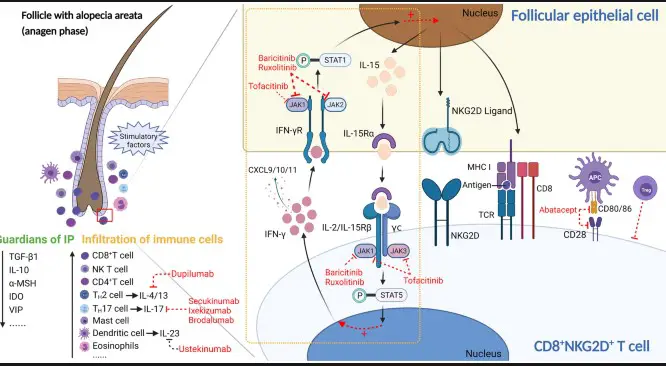Hair loss is a common condition that affects millions of people around the globe. There are many causes of hair loss, ranging from genetics to lifestyle-related factors. Two of the most common causes of hair loss are alopecia areata and tinea capitis.
Two of the most common causes of hair loss are alopecia areata and tinea capitis. In this blog article, we’ll examine the differences between these two conditions and discuss the treatments available.
Causes of alopecia areata and tinea capitis

Alopecia areata and tinea capitis are both common types of hair loss, but they have distinct differences. Alopecia areata is an autoimmune condition that causes patchy hair loss and is thought to be caused by an overactive immune system attacking the hair follicles. Tinea capitis, on the other hand, is a fungal infection that affects the scalp and causes the hair to break off at the scalp line.
While both conditions can cause hair loss, they require different treatments. Alopecia areata is usually treated with topical corticosteroids, while tinea capitis is typically treated with antifungal medications.
Symptoms of alopecia areata and tinea capitis

Alopecia areata and tinea capitis are two different hair loss conditions, both of which can cause patchy hair loss and scalp irritation. The primary difference between the two is that alopecia areata is an autoimmune disorder, while tinea capitis is a fungal infection.
Common symptoms of alopecia areata include itching, burning, and soreness at the affected area. Tinea capitis, on the other hand, is a fungal infection of the scalp that is caused by a type of fungus called dermatophytes.
This infection is most commonly seen in children, and common symptoms include scaling, itching, and brittle hair. To differentiate between alopecia areata and tinea capitis, your doctor will likely perform a physical examination and take samples of your scalp to be analyzed in a laboratory. Treatment for alopecia areata typically involves corticosteroid injections or topical medications, while tinea capitis is usually treated with antifungal medications.
Treatment for alopecia areata typically involves corticosteroid injections or topical medications, while tinea capitis is usually treated with antifungal medications.
Diagnosis of alopecia areata and tinea capitis
Alopecia areata and tinea capitis are both conditions that lead to hair loss, but they have different causes and treatments. Alopecia areata is an autoimmune disease in which the body’s immune system mistakenly attacks the hair follicles, causing hair loss in round patches. Tinea capitis, on the other hand, is a fungal infection of the scalp that can lead to hair loss and scaly patches.
Tinea capitis, on the other hand, is a fungal infection of the scalp that can lead to hair loss and scaly patches. Treatment of alopecia areata often involves topical and/or injected corticosteroids, while tinea capitis is typically treated with antifungal medications. It is important to differentiate between these two conditions in order to provide the most effective treatment.
Treatment of alopecia areata and tinea capitis
Alopecia areata and tinea capitis are both medical conditions that cause hair loss, but they are quite distinct from one another. Alopecia areata is an autoimmune disorder that causes patchy hair loss, while tinea capitis is a fungal infection of the scalp that leads to bald patches. The treatment protocols for each condition are very different – alopecia areata is often treated with topical medications, while tinea capitis can be treated with antifungal medications as well as topical therapies.
The treatment protocols for each condition are very different – alopecia areata is often treated with topical medications, while tinea capitis can be treated with antifungal medications as well as topical therapies. It’s important to note that alopecia areata is not contagious, whereas tinea capitis is, making it important to seek treatment for the infection as soon as possible.
Prevention of alopecia areata and tinea capitis

Alopecia areata and tinea capitis are both conditions that can lead to hair loss, but the causes and treatments are quite different. Alopecia areata is an autoimmune disorder, in which the body’s immune system mistakenly attacks the hair follicles, leading to patchy hair loss. It can affect both men and women and is often triggered by stress.
It can affect both men and women and is often triggered by stress. Tinea capitis, on the other hand, is a fungal infection that affects the scalp and is most common among children. It is caused by a fungus, which leads to itchy, scaly patches of hair loss.
Treatment for both conditions varies, but for tinea capitis, antifungal medications are typically used, while for alopecia areata, treatments such as topical corticosteroids, topical minoxidil, and intralesional corticosteroids are common. Ultimately, to prevent either condition, it is important to practice good hygiene and watch out for any signs of infection or other health issues.
Bottom Line
In conclusion, alopecia areata and tinea capitis are both conditions of hair loss. However, they have different causes and treatments.
Tinea capitis is a fungal infection that causes patches of hair loss, and is treated with antifungal medications. Both conditions can cause significant psychological distress, so it is important to seek treatment as soon as possible.

